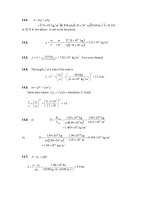Tài liệu GENERAL RADAR DISPLAY TYPES pdf
Bạn đang xem bản rút gọn của tài liệu. Xem và tải ngay bản đầy đủ của tài liệu tại đây (34.84 KB, 3 trang )
TGT 1
TGT 2
TGT 3
ANGEL
(GHOST)
NOISE
RAW VIDEO
TGT 1
TGT 2
TGT 3
ANGEL (GHOST) - see text
SYNTHETIC VIDEO
5-5.1
Figure 1. Radar Display Types
GENERAL RADAR DISPLAY TYPES
There are two types of radar displays in common use today.
RAW VIDEO
Raw video displays are simply oscilloscopes that display the detected and amplified target return signal (and the
receiver noise). Raw video displays require a human operator to interpret the various target noise and clutter signals.
On the left hand display of Figure 1, an operator could readily identify three targets and a ghost (a ghost is a phony
target that usually fades in and out and could be caused by birds, weather, or odd temporary reflections - also referred to
as an angel). Target 3 is a weak return and hidden in the noise - an operator can identify it as a target by the "mouse under
the rug" effect of raising the noise base line.
SYNTHETIC VIDEO
Synthetic video displays use a computer to clean up the display by eliminating noise and clutter and creating it's
own precise symbol for each target.
On the right hand display target 1 comes and goes because it is barely above the receiver noise level - notice that
it is quite clear on the raw video. Target 3 wasn't recognized by the computer because it's to far down in the noise. The
computer validated the ghost as a target. The ghost might be a real target with glint or ECM characteristics that were
recognized by the computer but not the operator.
A
M
P
L
I
T
U
D
E
Noise
Target
(-)
(+)
0
Target
R
A
N
G
E
E
L
E
V
A
T
I
O
N
Target
180E
90E
270E
0E
0
SECTOR PPI
PPI
A-SCOPE
B-SCOPE / E-SCOPE
C-SCOPE
Azimuth
Target
Target
R
A
N
G
E
AZIMUTH / ELEVATION
RANGE or VELOCITY
AZIMUTH
5-5.2
Figure 2. Common Radar Displays
SEARCH AND ACQUISITION RADARS
They generally use either a PPI or a sector PPI display as shown in Figure 2. PPI displays can be either raw video
or synthetic video.
PPI scope (plan position indicator).
Polar plot of direction and distance.
Displays all targets for 360 degrees.
Sector PPI scope.
Polar plot of direction and distance.
Displays all targets within a specific sector.
Origin may be offset so that "your" radar position may be off the scope.
TRACKING RADARS
Usually use some combination of A, B, C, or E scope displays. There are many other types of displays that have
been used at one time or another - including meters - but those listed here are the most common in use today.
5-5.3
A-SCOPE
Target signal amplitude vs range or velocity.
Displays all targets along pencil beam for selected range limits.
Displays tracking gate. Usually raw video. Some modern radars have raw video a-scopes as an adjunct
to synthetic video displays.
Must be used with a separate azimuth and elevation display of some sort.
Also called a range scope (R-Scope).
B-SCOPE
Range vs azimuth or elevation. Displays targets within selected limits.
Displays tracking gate. May be raw or synthetic video.
Surface radars usually have two. One azimuth/one elevation which can result in confusion with multiple
targets.
C-SCOPE
Azimuth vs elevation. Displays targets within selected limits of az and el.
Displays tracking gate. May display bull's-eye or aim dot.
May have range indicator inserted typically as a marker along one side. Usually synthetic video.
Pilots eye view and very common in modern fighter aircraft heads up displays for target being tracked.
Could be used in any application where radar operator needs an "aiming" or "cross hair" view like a rifle
scope.
E-SCOPE
Elevation vs Range similar to a B-scope, with elevation replacing azimuth.









